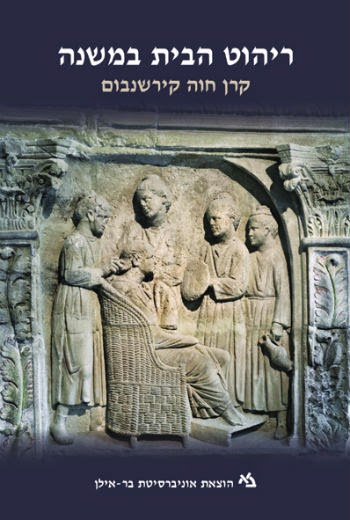Go to bed!
Moed Katan 27
Dr. Keren Kirshenbaum recently published a book called ריהוט הבית במשנה (Bar
Ilan University Press). It is an exhaustively scholarly attempt to understand
what furniture looked like in the time of the Mishnah. Her sources are Rabbinic
literature (mainly from Eretz Yisrael since Babylonia
had a different material culture), classical authors and of course, archaeology,
which has immeasurably enriched our knowledge of this subject through
discoveries in the last fifty years. She looks primarily at four pieces of
furniture: chairs, tables, beds and storage items. It is not light reading but
if understanding the way of life of the Tannaim and Amoraim is important to
you, get this book!
http://www.biupress.co.il/website/index.asp?id=927
And now to our daf. In the course of a discussion about
which beds need to be upended during the mourning period, we hear about a bed
called a דרגש . Naturally, the gemara asks what this is.
We hear three answers: a דרגש is an ערסא דגדא ;
or perhaps an ערסא דצלא, a leather bed; and finally,
a bed whose supports are woven differently than a regular bed.
What is an ערסא דגדא ?
Rashi explains that it is a bed that is not used but is meant to bring good
luck to the household. Other sources, including Rashi in Hullin 40a, add an element of idolatry – that is for the שר הבית , the lucky talisman or god of the house.
Dr. Kirshenbaum expands on this idea by showing that in
Roman households, at the entrance to the house, there was often an unused bed.
This bed was called the lectus genitalis, the wedding night bed. (Lectus means a bed). It was
high and to reach it you needed a stepstool. After the bed was used on that
auspicious occasion, it was placed in the atrium and changed its name to the lectus
adversus. (Adversus means opposite, in this case opposite the entrance). There it waited for the next wedding. She suggests that the
Aramaic name was connected toגד , meaning a male child, as in Bereshit 30 when
Gad is born.
A lectus (though not
necessarily a lectus genitalis), from a fresco found in Pompeii
www.forum romanum.org
Is it likely that Jews used such a Roman piece of furniture
as an ערסא דגדא ? Yet another fascinating
example about how material culture was often shared by people with opposing
world views.
See you soon in Hagigah!





Comments
Post a Comment